Külli Luha
Analyst of the Courts Division of the Ministry of Justice
In 2022, 35,089 civil matters (2.4% increase compared to 2021) and 51,712 expedited payment order matters (18.4% increase compared to 2021), 12,389 criminal matters, [1]including 3,877 criminal matters (18.6%) less than in 2021); 5,113 misdemeanour matters (7.0% less than in 2021) were received by county courts for adjudication. A total of 2,770 administrative matters were received by administrative courts for adjudication (11.2% less than in 2021).
The figures below (figures 1-3) show the number of civil, criminal and misdemeanour matters and administrative matters that have been received by county and administrative courts during the last ten years.
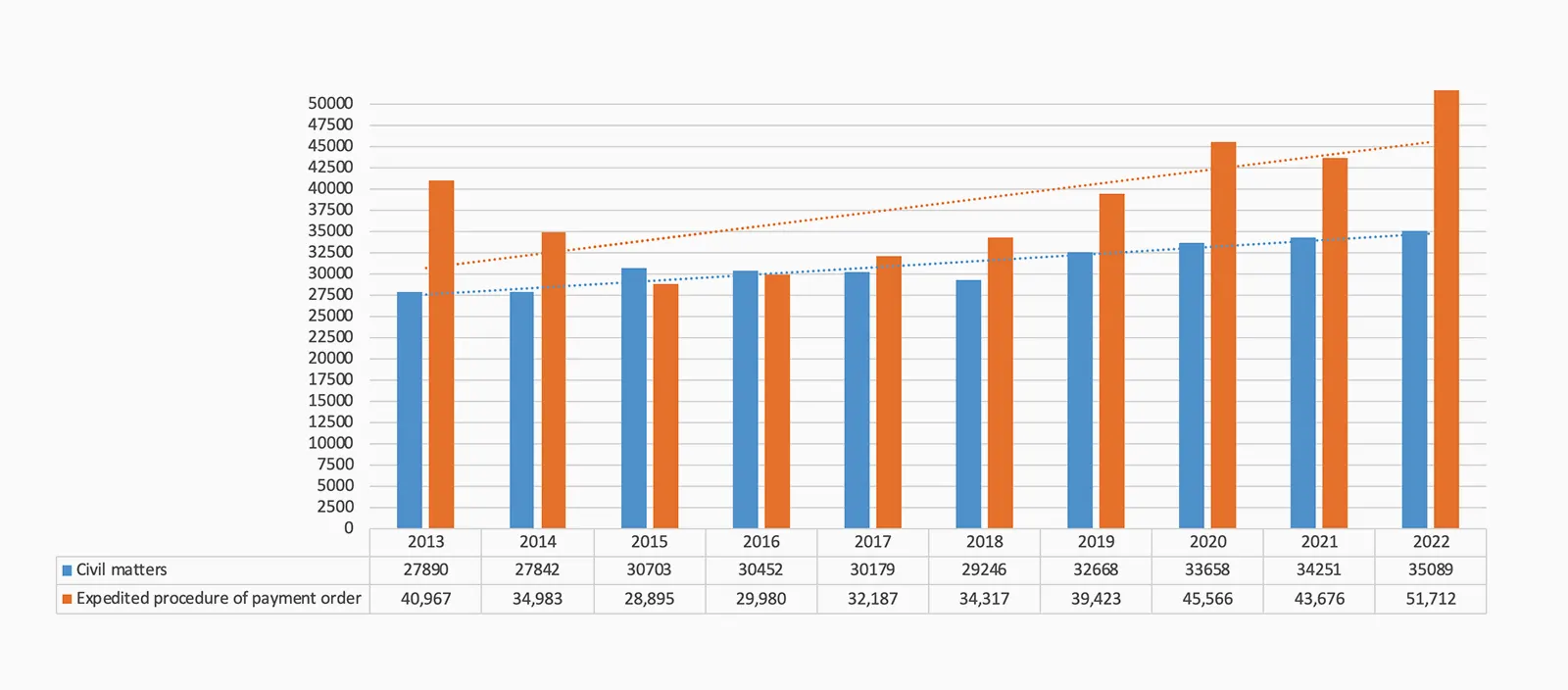

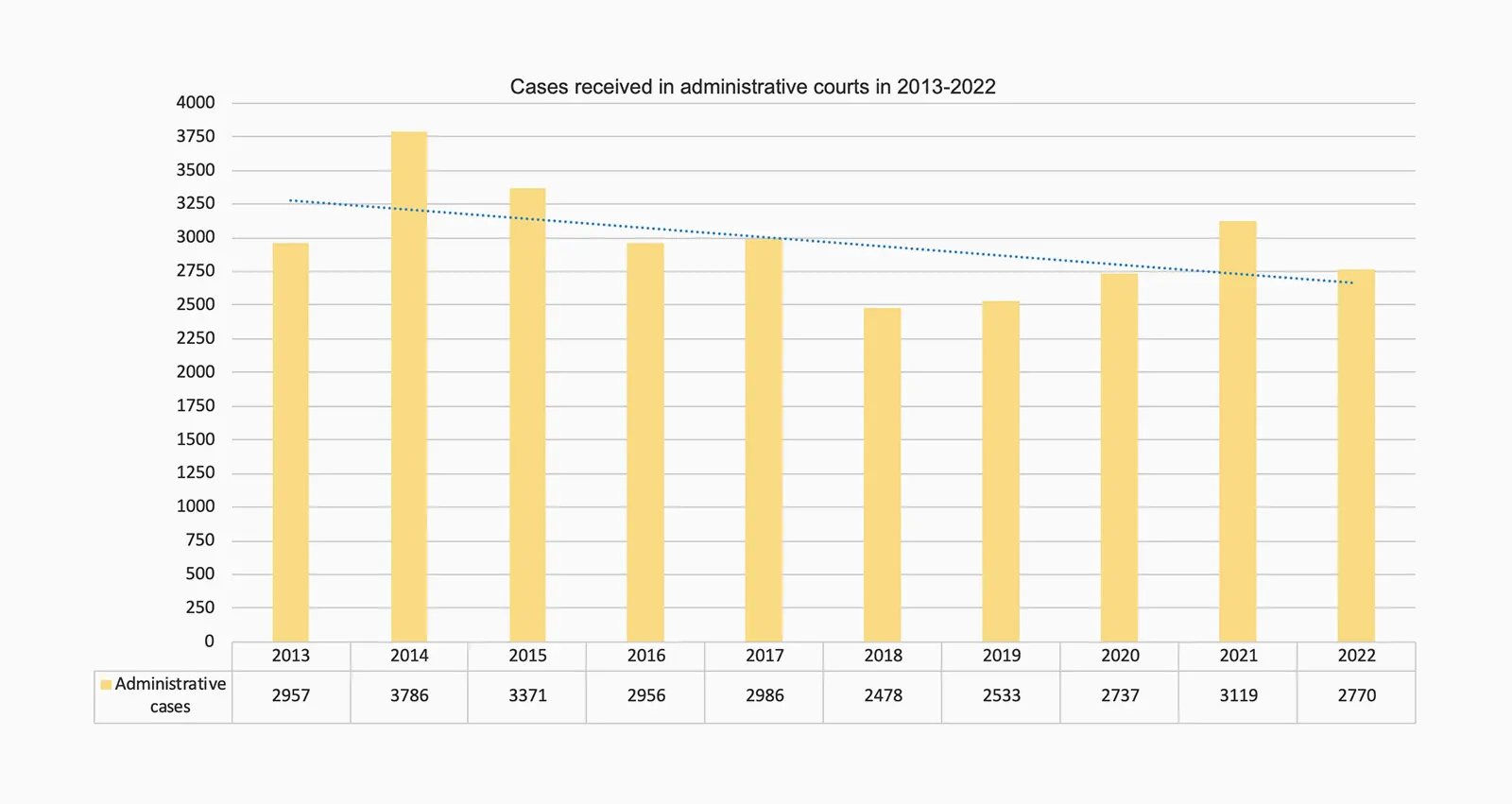
A total of 2,792 civil matters (9.3% less than in 2021), 1,365 administrative matters (6.3% less than in 2021) came to the circuit courts in the appeal and ruling appeal procedure. There were 1,635 criminal procedure matters (10.1% less than in 2021) and 147 misdemeanour procedure matters. The figure below (Figure 4) shows the change in the number of matters received by circuit courts in all types of proceedings over the last ten years.

More detailed data on the 2022 procedural statistics of courts of first and second instance by type of procedure have been published on the courts’ website.[3]
Use of paperless (digital) procedure in courts
On 1 April 2023, civil and administrative court proceedings will transition to paperless court proceedings[4]. In this regard, we look at how popular digital records are in the courts and whether and how the digital records affect the duration of proceedings.
Paperless procedure started to be implemented in the courts in 2017. In recent years, its use has increased significantly, reaching 59% of civil matters, 65% of administrative matters and 66% of misdemeanour matters in 2022.
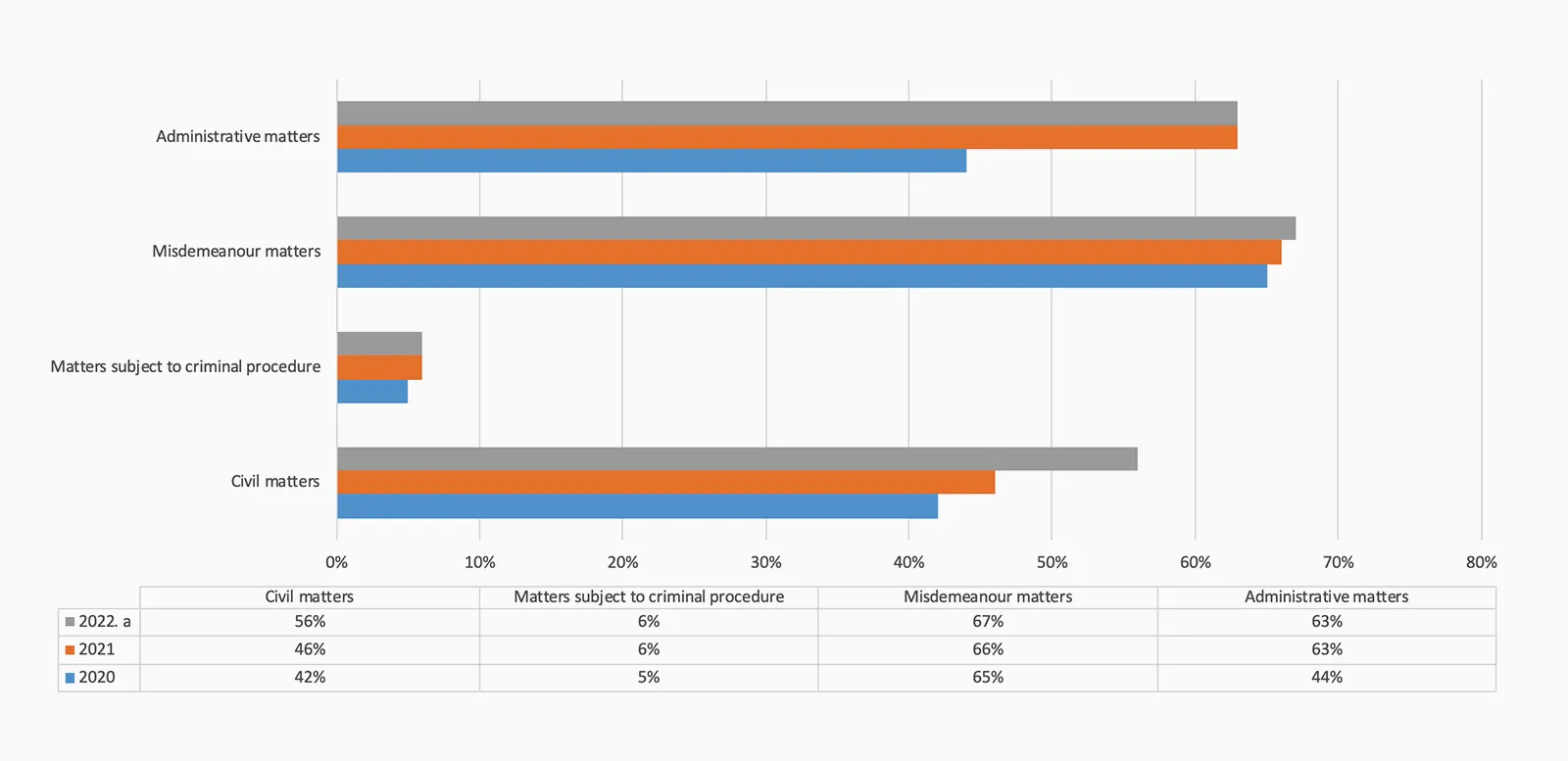
Taking a closer look at the proportion of matters adjudicated in the digital procedure in the county and administrative courts, it appears that the popularity of the digital procedure varies from court to court even within the same type of procedure.
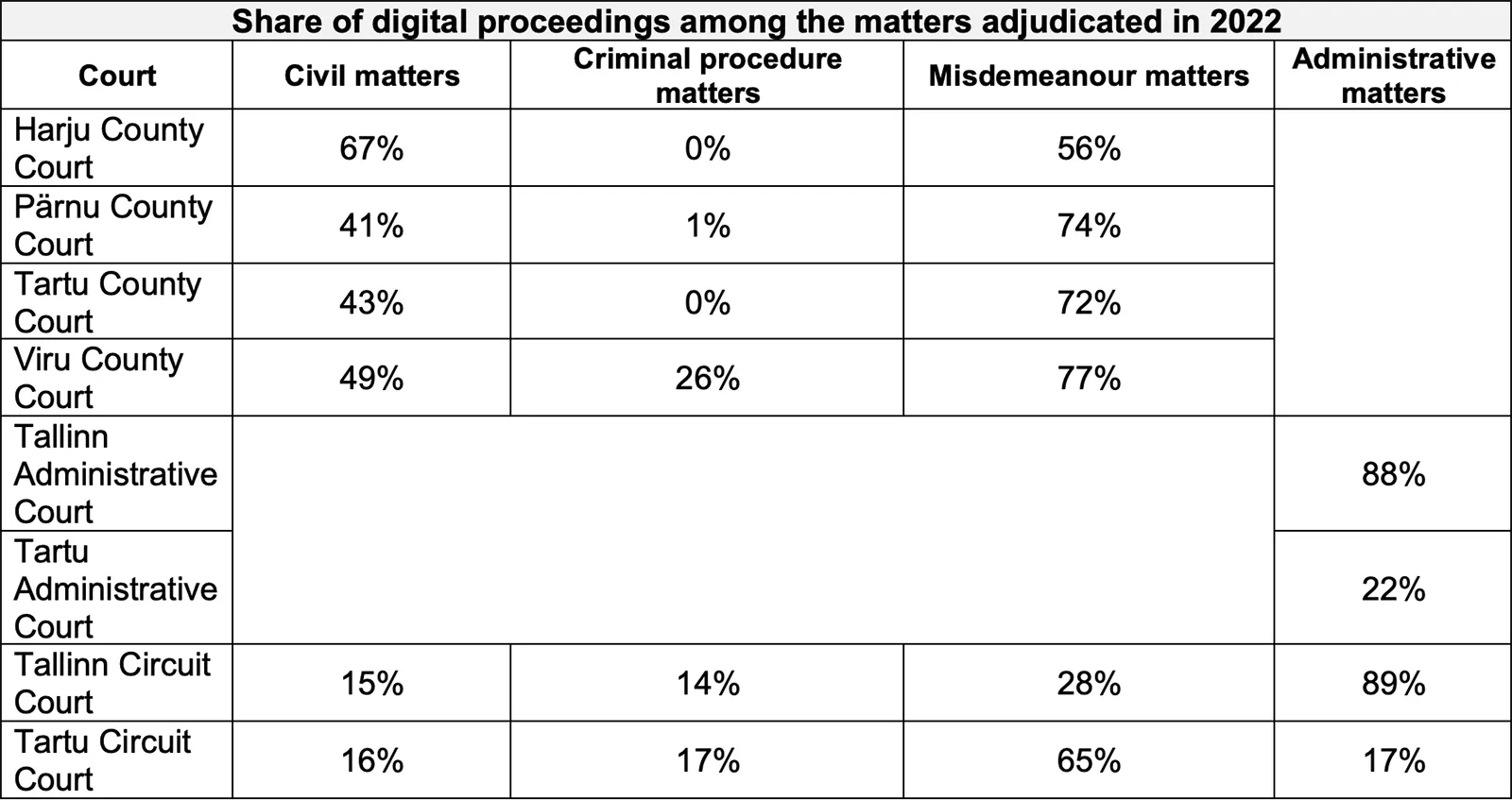
In 2022, 67% of civil matters were adjudicated in Harju County Court in digital proceedings. In this court, the digital system have become standard – 80% of the judges process more than half of their pending matters in digital proceedings, (with 14 judges processing at least 80% of the matters using the digital system). In Pärnu County Court, the share of digital proceedings was 41% of the adjudicated matters, while 19% of the judges of this county court adjudicated more than half of the matters using the digital system In Tartu County Court, the proportion of digital proceedings was 43% (more than half of the matters were adjudicated in digital proceedings by 25% of the judges). In Viru County Court, the proportion of digital proceedings was 49% (more than half of the matters were adjudicated in digital proceedings by 29% of the judges).
In recent years, the digital system has been the main resource used by of all judges on Tallinn Administrative Court. In 2022, the share of digital proceedings accounted for 88% of the matters adjudicated in the administrative court, with 13 judges processing practically all matters in paperless manner.
Although there are no developments in the near future in the implementation of the digital system in criminal matters, digital proceedings have also become a valuable tool for county judges in misdemeanour matters. In 2022, the proportion of paperless procedures in this type of proceeding was 56-77%.
Adjudication of matters in county courts: civil matters
A total of 34,460 civil matters were adjudicated in county courts, of which 17,695 were in Harju County Court, 4,253 in Pärnu County Court, 7,597 in Tartu County Court and 4,915 in Viru County Court.
Looking at the content of adjudicated matters, the matters adjudicated in 2022 were divided into areas that have developed in recent years, and thus the majority were family law, debt law and matters under the General Part of the Civil Code (70.3%).[5] Compared to the past, the number and proportion of insolvency matters decreased somewhat.
Figure 6 provides an overview of adjudicated civil matters by type, with a distinction being made between matters adjudicated on the basis of the digital system and paper or conventional file.
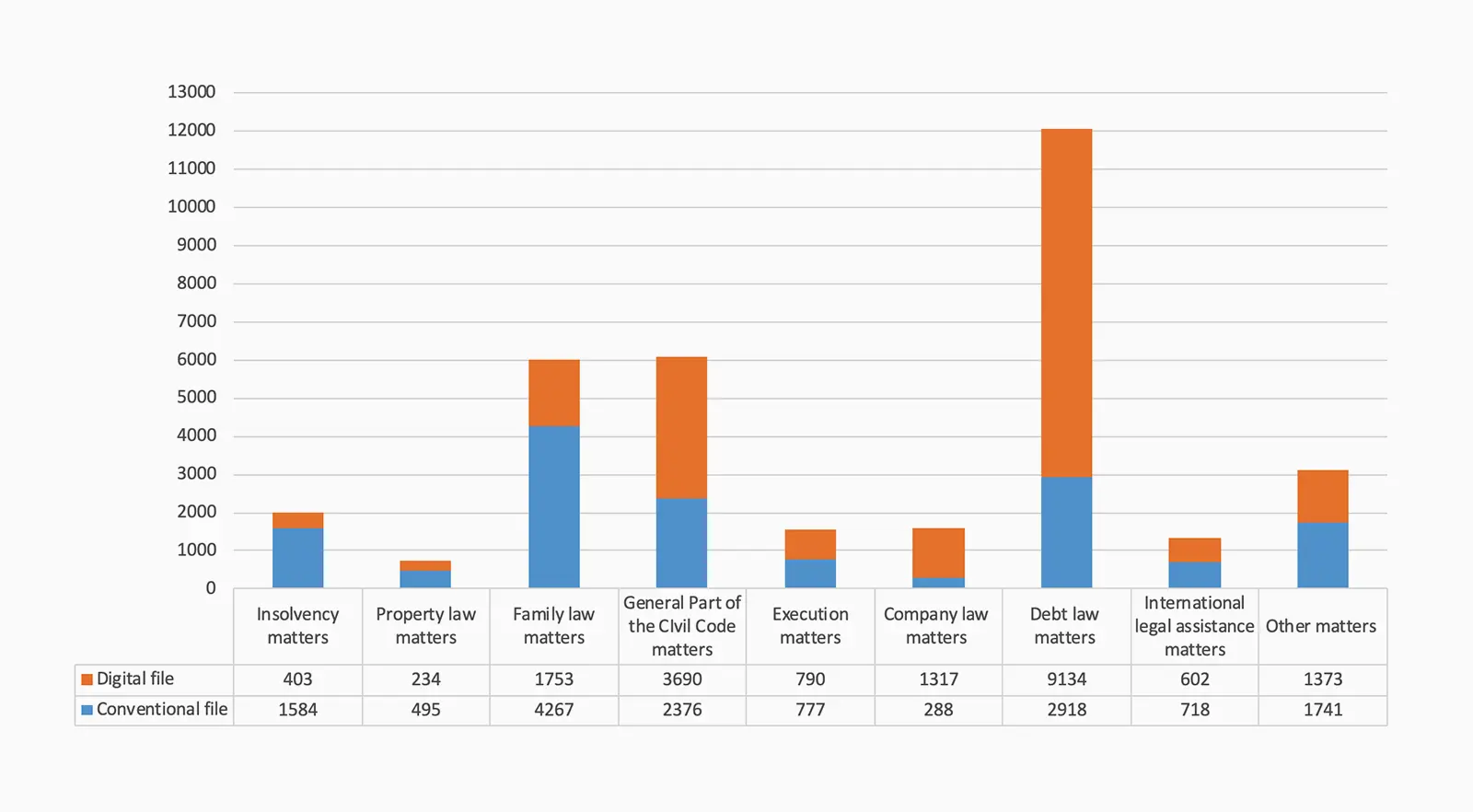
The share of digital proceedings is greater in the adjudication of debt law matters (26.5% of the total number of civil matters), in the adjudication of General Part of the Civil Code matters (share of digital proceedings is 10.7% of the total number of adjudicated civil matters) and in family law matters (share of digital proceedings – 5.1%).
In county courts, the average processing time of matters adjudicated in 2022 was 102 days, with the average processing time of matters adjudicated in digital procedure was 67 days, and the average processing time of matters adjudicated under so-called conventional procedure was 147 days. Figure 7 shows the average processing time of adjudicated civil matters in digital proceedings and matters adjudicated in proceedings based on a conventional file.
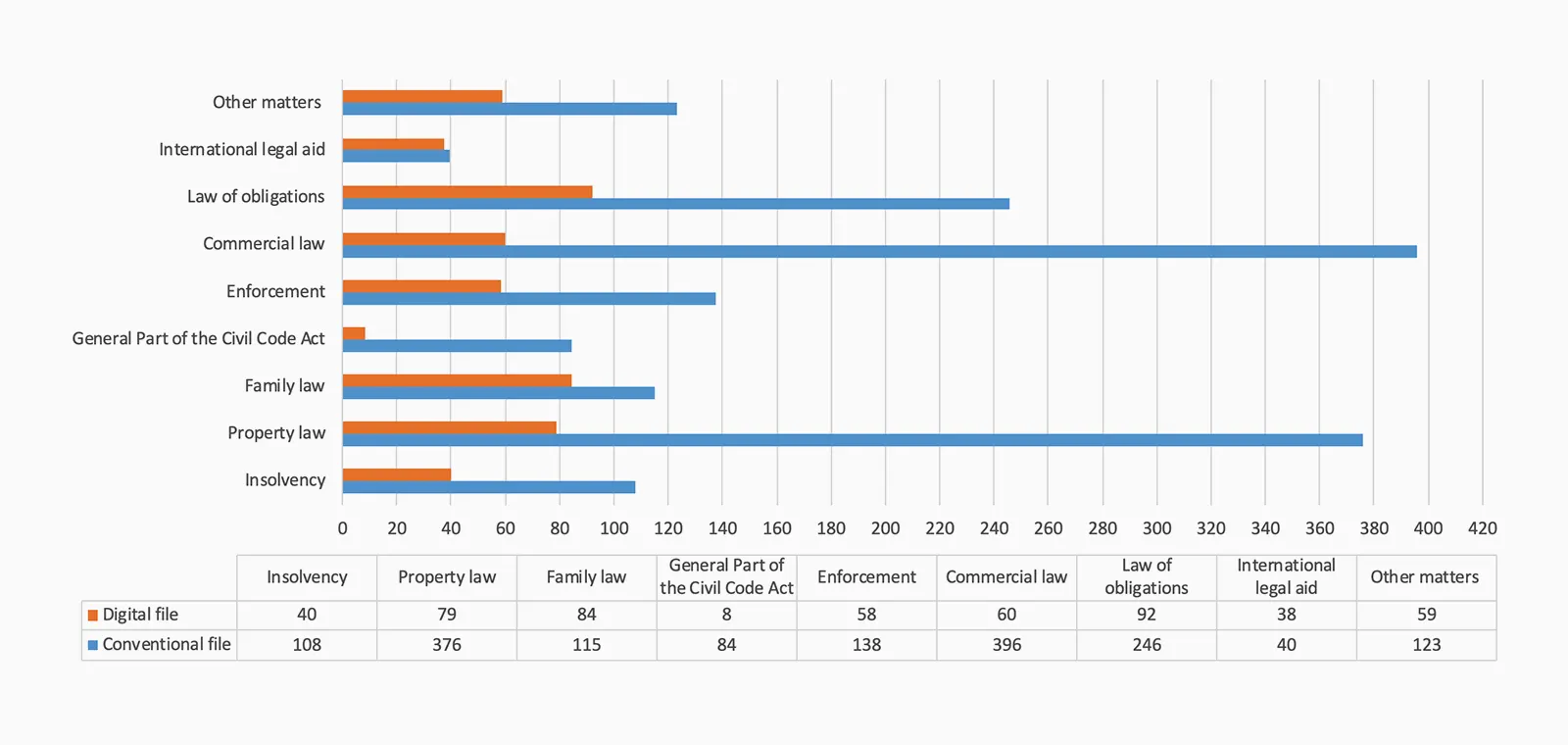
The data shows that the difference in the average processing time is particularly large in matters of property law and company law. If you look at the average processing time of matters substantively adjudicated in these types (not including default judgments), digital proceedings in such matters (a total of 226 company law and property law matters in county courts) turns out to be significantly shorter on average.
Adjudication of matters in administrative courts: administrative matters
In 2022, a total of 2,736 administrative matters were adjudicated in administrative courts: 1,679 matters in Tallinn Administrative Court and 1,057 matters in Tartu Administrative Court. By content of the complaint, law enforcement matters accounted for 35.0% of adjudicated matters, 7.5% were social justice matters, 7.1% and 6.7% were planning and construction matters.
Figure 8 provides an overview of adjudicated administrative matters by category, together with the share of the digital procedure shown separately.
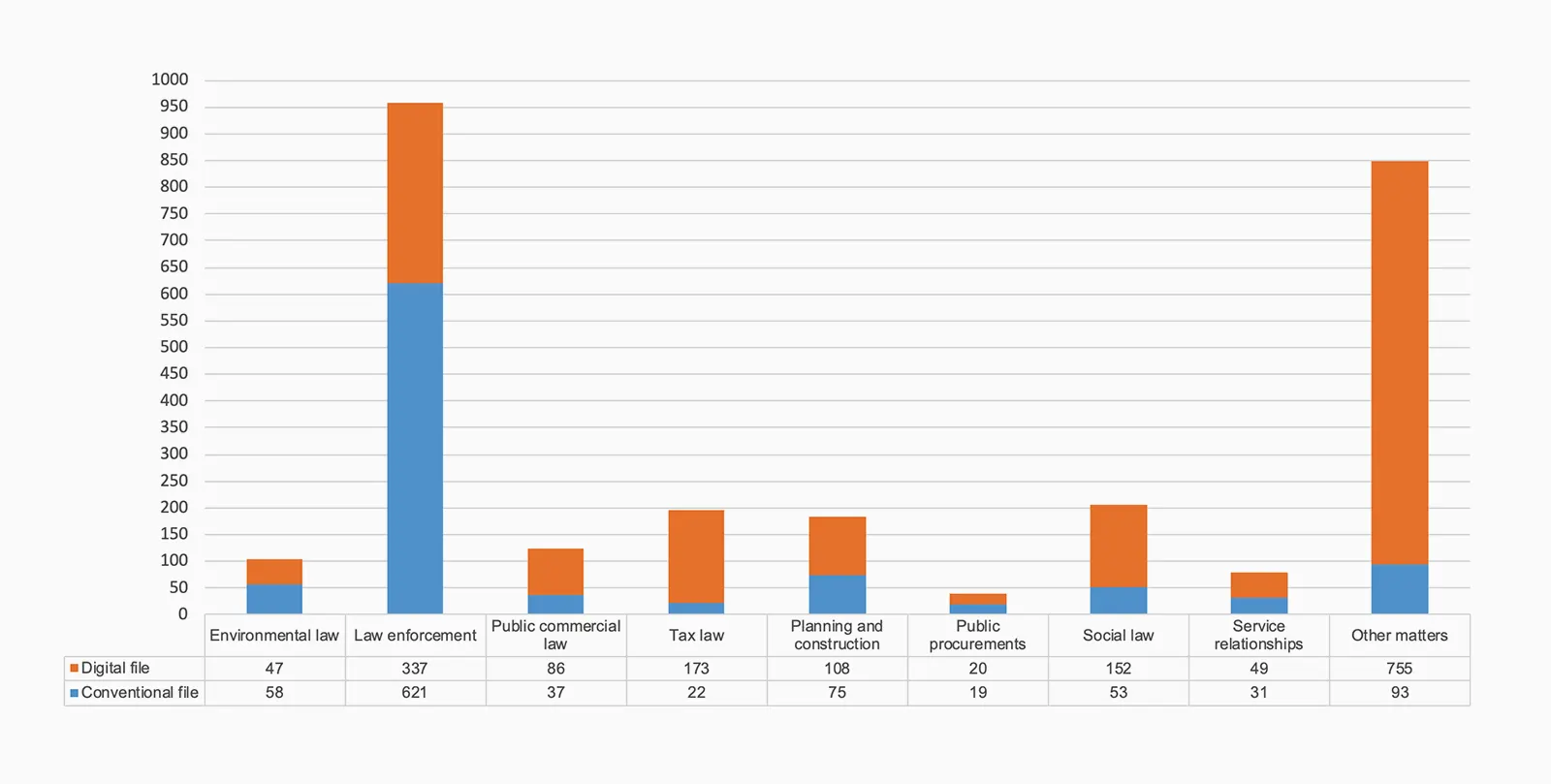
The share of digital procedure is higher in adjudication of law enforcement matters (35.0% of the total number of adjudicated matters). In the rest of the matters, the digital procedure is distributed more evenly, within 3-7%.
In county courts, the average processing time of matters adjudicated in 2022 was 149 days, with the average processing time of matters adjudicated in digital procedure was 124 days, and the average processing time of matters adjudicated under so-called conventional procedure was 194 days. Figure 9 shows the average processing time of adjudicated administrative matters, depending on whether the case was adjudicated under digital procedure or on the basis of a conventional file.

The proportion of digital proceedings in Tallinn and Tartu administrative courts is so different that it is not valid to compare the average procedure time.
Adjudication of matters in county courts: criminal matters
A total of 12,392 criminal procedure matters and 4,878 misdemeanour procedure matters were adjudicated in the county courts, which were divided as follows: 22.6% of the total number of all matters involving offences were criminal matters (i.e. general, settlement, summary and injunction matters together), 23.2% were matters of judges in charge of the execution of court judgments, 17.6% were preliminary investigation judge matters and 28.3% were misdemeanour matters (Figure 10).
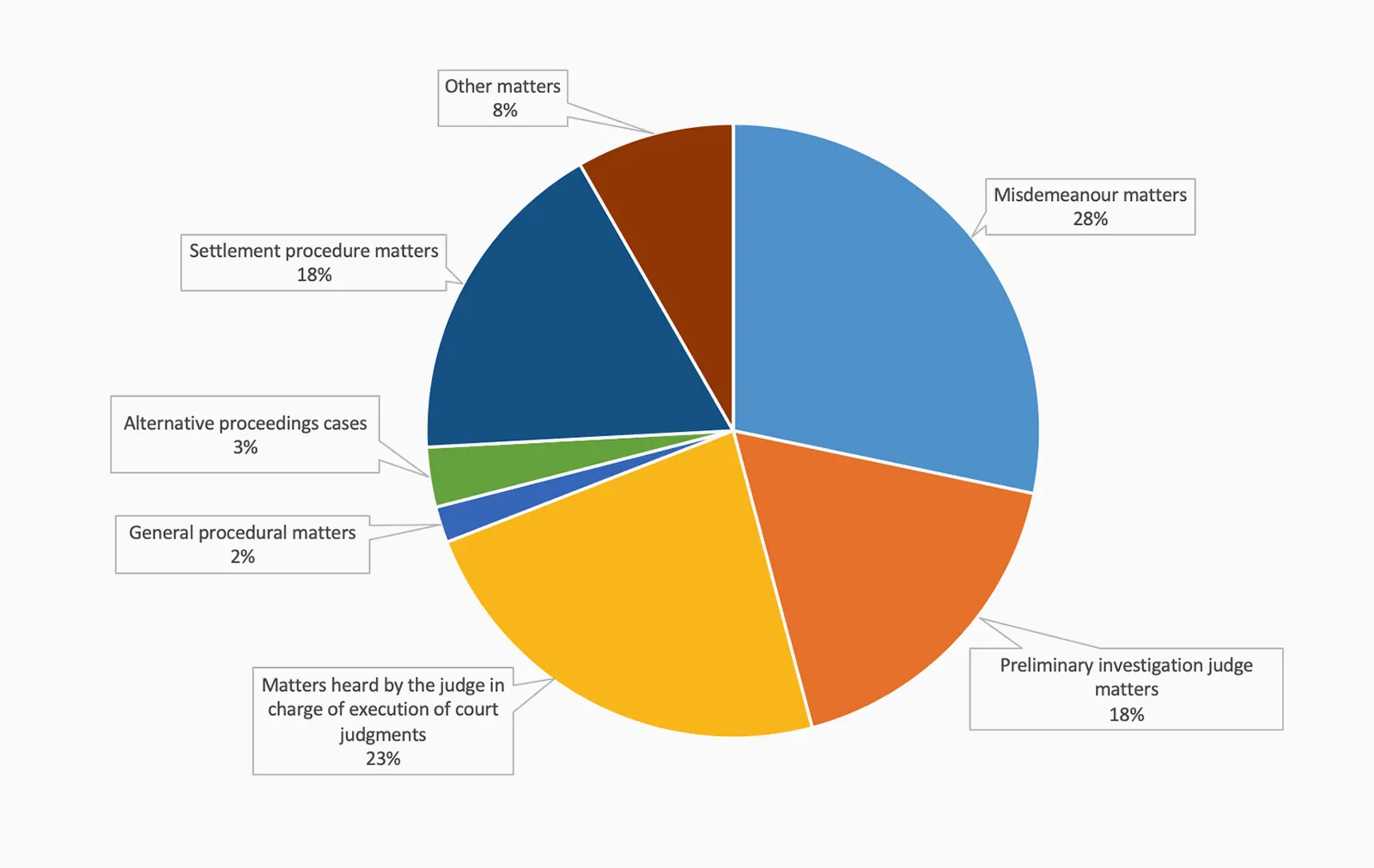
In criminal proceedings, the share of digital proceedings is modest, and the digital system is mostly used in the matters heard by the preliminary investigation judge and the Viru County Court. In this court, 95.2% of the preliminary investigation judge’s matters were adjudicated using paperless procedure.
In misdemeanour matters, in 2022, 96.1% of all execution matters were adjudicated in county courts in a paperless procedure (mainly requests for the application of a alternative punishment to a person).
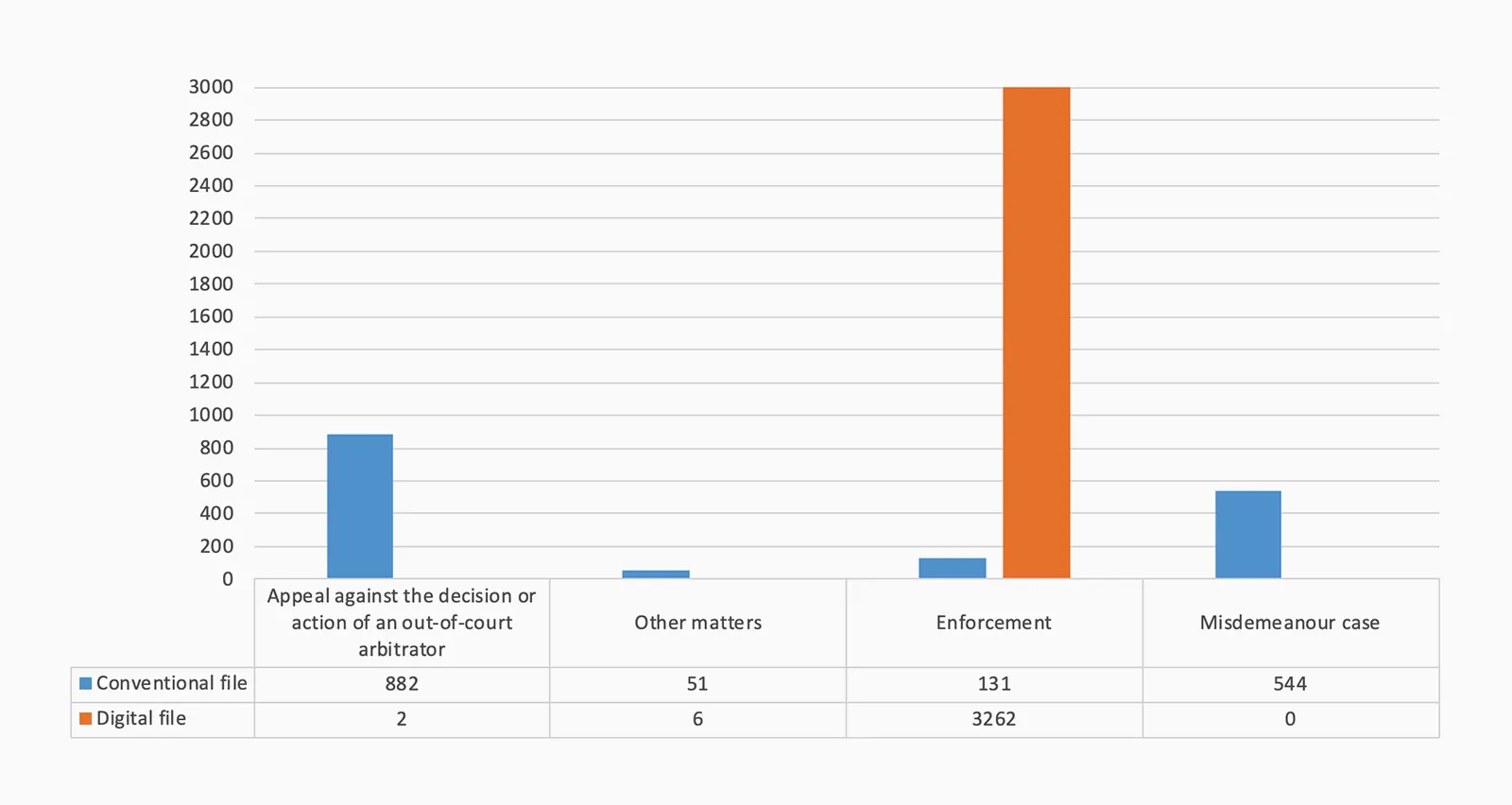
Adjudication of matters in circuit courts: civil matters
In 2022, a total of 2,725 civil matters were adjudicated in the circuit courts (1,884 in the Tallinn Circuit Court and 841 in the Tartu Circuit Court), including 1,184 in appeals and 1,541 in appeals against court rulings.
Debt law (33.2%), family law (14.6%) and insolvency matters (9.5%) accounted for more than half of the matters adjudicated substantively in the circuit courts. The substantive division and share of digital proceedings is shown in the figure.

Of the matters adjudicated in 2022, the share of digital proceedings in appeal and appeal against court rulings in the Tallinn Circuit Court was 17.6% and in the Tartu Circuit Court, 23.8%.
In the circuit courts, civil matters in the appeal procedure were adjudicated in an average of 197 days (213 days in the Tallinn Circuit Court and 158 days in the Tartu Circuit Court).

Civil matters adjudicated in circuit courts accounted for 5.4% of those adjudicated in county courts.
Adjudication of matters in circuit courts: administrative matters
In 2022, a total of 1,287 administrative matters were adjudicated in the circuit courts (765 in the Tallinn Circuit Court and 522 in the Tartu Circuit Court), including 543 in appeals and 843 in appeals against court rulings.
Based on the content, the greatest share of law enforcement matters were adjudicated in circuit courts (36.9% of adjudicated matters). Of the remaining 60%, planning and construction (10.0%), tax law (8.2%) and other administrative matters (24.9%) made up the majority. Figure 14 shows administrative matters adjudicated in circuit courts by content:
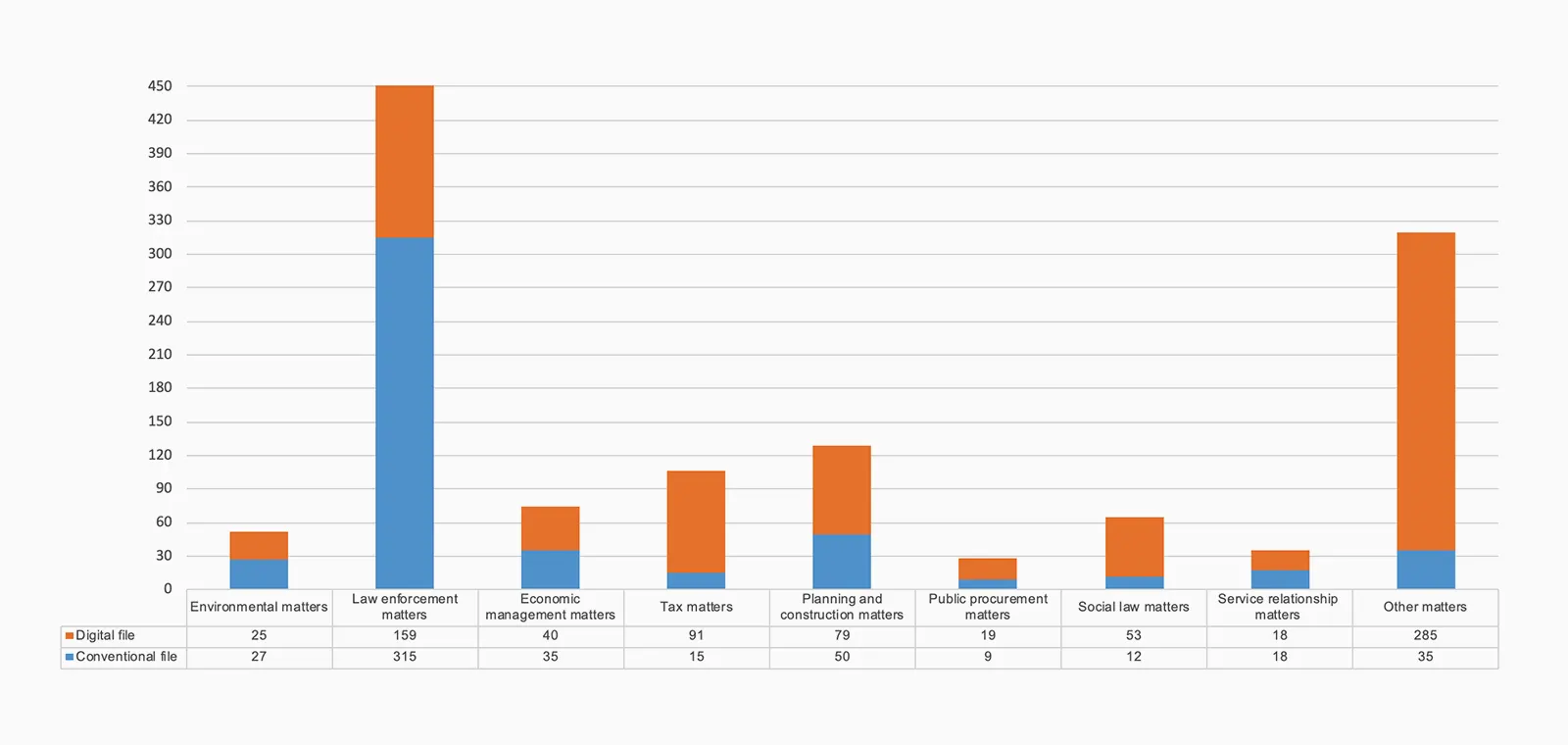
The proportion of matters adjudicated using digital proceedings was 88.9% in the Tallinn Circuit Court and 17.4% in the Tartu Circuit Court in appeals and appeals of court rulings.

In the circuit courts, administrative matters in appeals were adjudicated in an average of 257 days (238 in the Tallinn Circuit Court and 301 days in the Tartu Circuit Court).

Administrative matters adjudicated in circuit courts accounted for 32.0% of those adjudicated in administrative courts.
Adjudication of matters in circuit courts: matters involving offences
In the course of 2022, a total of 1,650 criminal matters were adjudicated in circuit courts (883 in Tallinn Circuit Court and 815 in Tartu Circuit Court), including
316 criminal matters in appeal proceedings, 1,165 matters in appeal of court rulings and 169 matters initiated by the circuit court. A total of 144 misdemeanour matters were adjudicated, including 64 in the Tallinn Circuit Court and 80 in the Tartu Circuit Court.
A quarter of the matters adjudicated in the circuit courts were criminal matters (23.6%), 15.8% were matters heard by the preliminary investigation judge, while the largest number (38.7% of matters adjudicated) were matters of judges in charge of the execution of court judgments. The proportion of misdemeanour matters adjudicated in criminal chambers was 8%. A more detailed breakdown is shown in Figure 17.
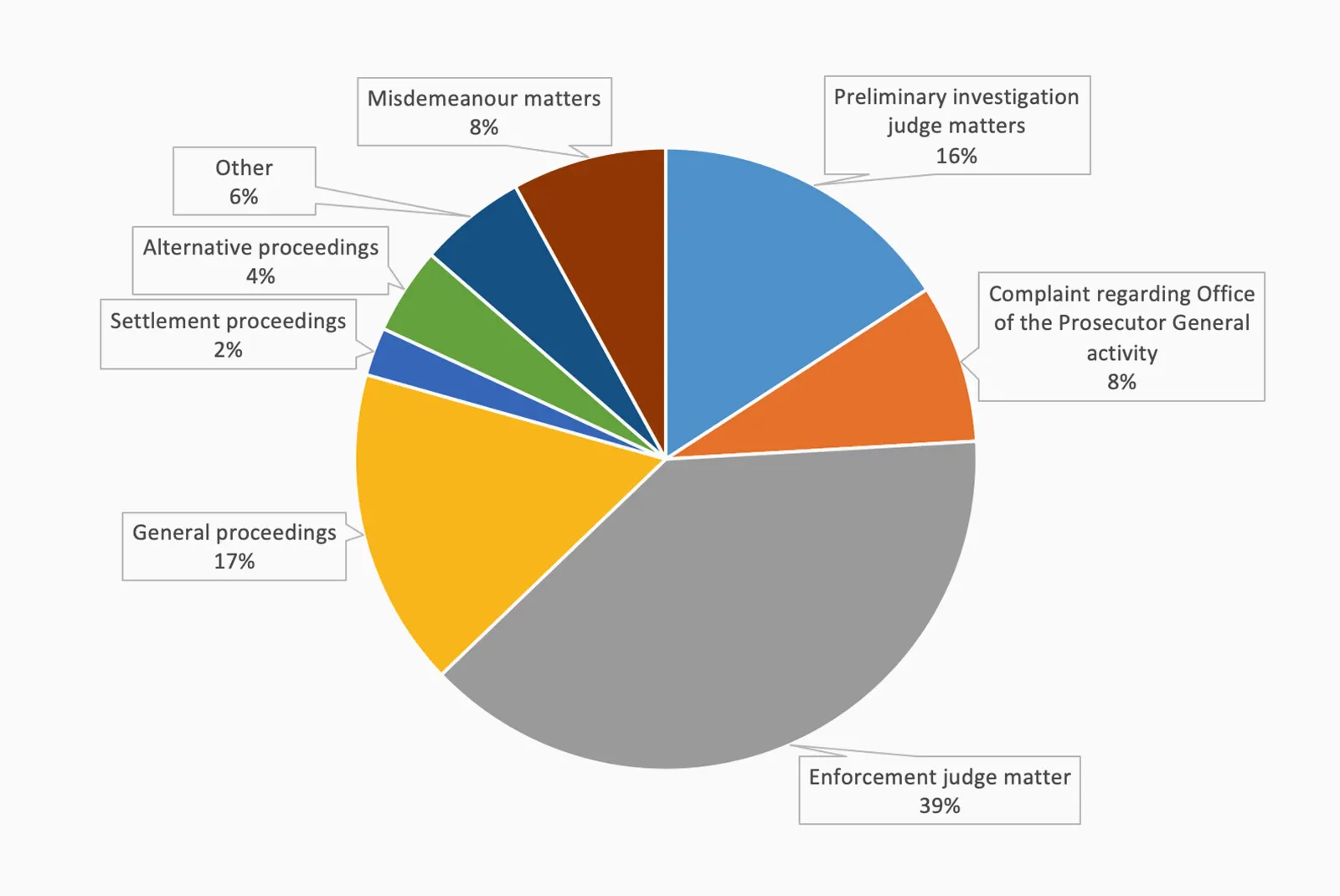
Criminal matters adjudicated in circuit courts accounted for 10.4% of those adjudicated in county courts.
In the circuit courts, criminal matters in appeals were adjudicated in an average of 81 days (74 in the Tallinn Circuit Court and 88 days in the Tartu Circuit Court).

The workload of a judge based on the matters of 2022 and changes in the workload of the position in recent years
The figures below show the judge’s workload in 2022. Figure 19 shows the so-called statistical load of judges of the first and second instance, which takes into account the sectoral specialisation of judges, unfilled positions of judges and longer absences from work. For example, taking into account the above, in 2022, each judge of the Harju County Court handling civil matters received an average of 446.1 civil matters with different time durations, and each judge handling matters involving offences received an average of 370.3 matters with different time durations.

In the case of county and administrative courts, the calculation based on the workload methodology is more accurate than the case-based calculation. The aresult of this methodology is the average estimated time spent per judge related to the adjudication of matters. Figure 20 below shows the workload of the judge position based on the workload methodology of the courts, with the workload of both the civil sector and matters involving offences being summed up. Thus, for example, comparing the workload of the position in the last four years, the workload was the highest in county courts in 2020 and in administrative courts in 2021

____________________________
[1] Background information. Crime statistics. – https://www.just.ee/kuritegevuse-statistika . Criminal procedure matters are considered to be all matters received by county courts in criminal proceedings, which are divided as follows: preliminary investigation judge matters, matters of judges in charge of the execution of court judgments, settlement matters, summary procedure matters, injunction procedure matters, general procedure matters, compulsory psychiatric treatment matters, international cooperation matters and state legal aid matters.
[2] The total number of civil matters filed in the county courts and the expedited payment order matters filed in the Haapsalu courthouse of the Pärnu County Court are included, supervision procedures are excluded.
[3] Aggregate data on procedural statistics of courts of first and second instance. Number of matters received and the number of matters adjudicated in 2022, as well as the average processing time and adjudication performance. – https://www.kohus.ee/sites/default/files/dokumendid/I%20ja%20II%20astme%20kohtute%202022.a%20menetlusstatistika.pdf (28.02.2023).
[4] Law on amending the Code of Civil Procedure and the Code of Administrative Procedure (transition to paperless court procedure). – RT I, 10.02.2023, 1.
[5] 99% of matters under the General Part of the Civil Code matters involve assigning guardianship to an adult with limited legal capacity and matters where a decision is made to commit a person to a hospital or other care facility.
[6]Background information. Serving on a panel of judges is not included in the workload of a circuit court judge.




